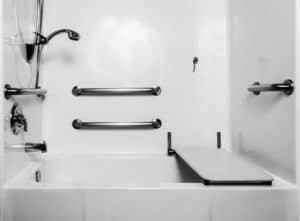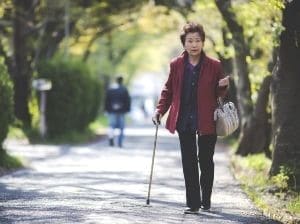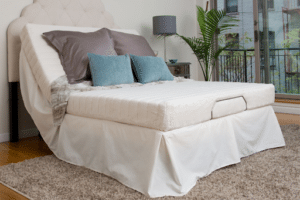
Most of us love large, luxurious bathrooms. But bathrooms for elders need special design features and a number of helpful components. The wrong tiling, lighting or sanitary fixtures can result in major inconveniences and dangerous mishaps.
The last thing any elder needs is a fall in their old, vulnerable age.
So, here are some safe and convenient ideas for a bathroom designed for older folk:
1) Non-slip flooring
Fancy tiles look great till they are wet and slippery. Most bathroom accidents and slips are due to soapy, wet floors in the shower, bath or even dry areas onto which the water sometimes overflows.. There is a wide and beautiful selection of anti-slip bath floor tiles to choose from. When purchasing online or from a store, double check the anti-slip properties of your tiles.
If you’re moving into a home that already has tiling, place non-slip mats in strategic positions. The spots from where one steps in and out of the shower and bath-tub, and inside the shower cubicle or bathtub. To be on the safer side, place non-slip runner mats along the length of the bathtub. Lay down a non-slip mat at the door of the bathroom as well.
Speaking of doors, wide, sliding doors on the entrance and shower are easier to handle than those with complicated locking systems. You can also consider a frameless shower door and install handles on them for the safety of the elderly.
2) Grab or holding bars and railings
Be sure to include short or long grab bars on the wall areas near the toilet, when getting out of the shower and in the dry area to assist elders at every point. The height of each bar should match its usage. For example, the ones near the toilet should be reachable when sitting down.
Good, solid holding bars are essential for elders with arthritis, weak muscles or post surgery. The latest statistics tell us that by 2040, close to 80 million Americans will be diagnosed with arthritis. So, holding bars will never be a wasteful idea and they are quite inexpensive to buy and install.
Plus, if the elders you are designing for need caretakers, these bars can also help them to assist better.
3) Shower bench or chair
Age affects our ability to balance. The solution is to offer a waterproof shower bench to sit on while bathing. Old folk can relax and stay calm instead of feeling traumatized and nervous every time they enter the shower.
Bath time is meant to rejuvenate and destress, but if standing upright is a task, a shower bench will help. Since they’re designed to be placed in the shower or bathtub, shower benches are stable and don’t slip around. They have small holes in the seat and back to allow water to drain out and prevent nasty collections. You can choose benches with armrests or without. Also, they are height adjustable.
4) High toilet with bidet
A high toilet would be one that is at least 17 inches from the floor. It’s better on aging knees and back to install a high toilet. Makes it easy to sit and get back up, especially when coupled with grab bars on the side.
Many elders suffer from weak bladders and when they need to go, they need to go! The toilet’s placement, therefore, should be close to the door for easy and quick access.
Many elders like the idea of a bidet as it helps them to clean themselves if needed, without depending on others. So consider installing one for the benefit of the aged.
5) Easy, well arranged storage
To begin with, an elderly’s bathroom should be minimalist in terms of the number of bottles, tubes and bath items being stored. Too much stuff will tend to spill over onto the floor causing them to bend over and pick up, every time.
Once you have decided on all essential bath products and bath aids for seniors, store them in pull out drawers rather than cupboards. Every item should be easily accessible, not too high nor too low. In fact, refrain from installing any drawers lower than average knee height.
Towels, wash cloth drawers should be close and within reach from the shower area. If you’re installing a shower bench, store soaps and shampoos in walled shelves or a sturdy shower caddy, at a lower height, so that one doesn’t need to stand up to take and put back bottles. Similarly, if it’s a normal shower situation, keep the shower caddy high enough so that one doesn’t need to bend to get stuff.
Another neat trick is to keep permanent dispensers that can be refilled instead of product bottles. These can fit right into the caddy cavities and can be accessed via a pump spray mechanism…. much simpler.
6) Walk-in tubs with doors and features
Walk-in tubs are genius ideas for elderly people’s bathrooms. These tubs eliminate the horrific possibility of tripping over the side or experiencing excruciating pain when stepping in and out of the tub. They also prevent chances of slipping on entering a tub.
The latest breed of walk-in tubs offer a range of features such as comfort seating, handrails and bubble jets. Check them all out before choosing.
7) Emergency alert systems
Even after taking the maximum precautions, you never know when an accident can occur. An alarm system in the bathroom can be as simple as a bell or an app-enabled emergency signal that pings emergency contacts within seconds.
Finally, plan the dimensions of the bathroom to accommodate walkers, wheelchairs if needed, without making it too big. Spacious bathrooms are always preferable than small, dingy ones but for elders, it takes more effort to move from the shower, to the toilet and back to the washbasin.
Most bathrooms and toilets that adhere to universal design rules are usually safe for elders. They take into consideration many of the points we’ve discussed above. However, all elders have their own needs and comfort levels, so if you’re designing for someone, it’s best to discuss your ideas with the seniors you’re designing for. Ask them for their inputs and recommendations and share your ideas with them to see how you can improve on every aspect, terms of safety and convenience.








